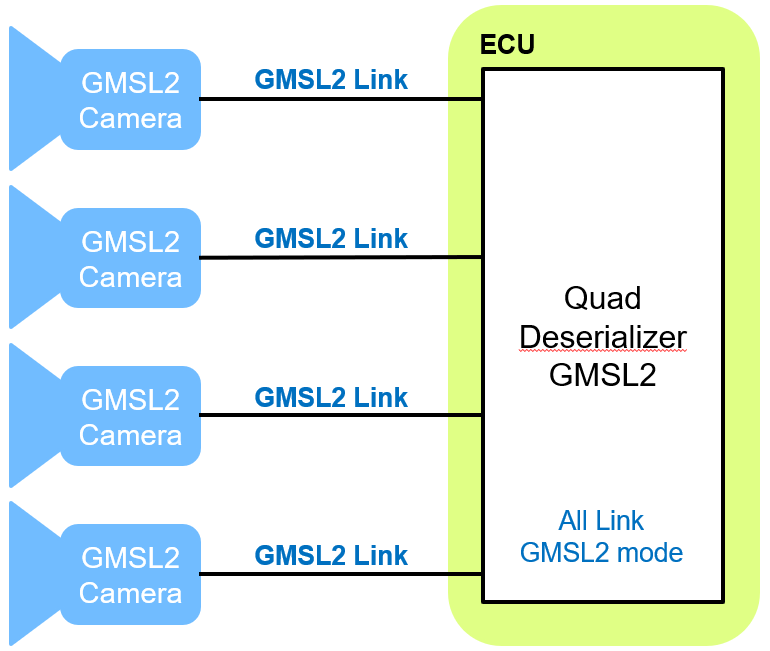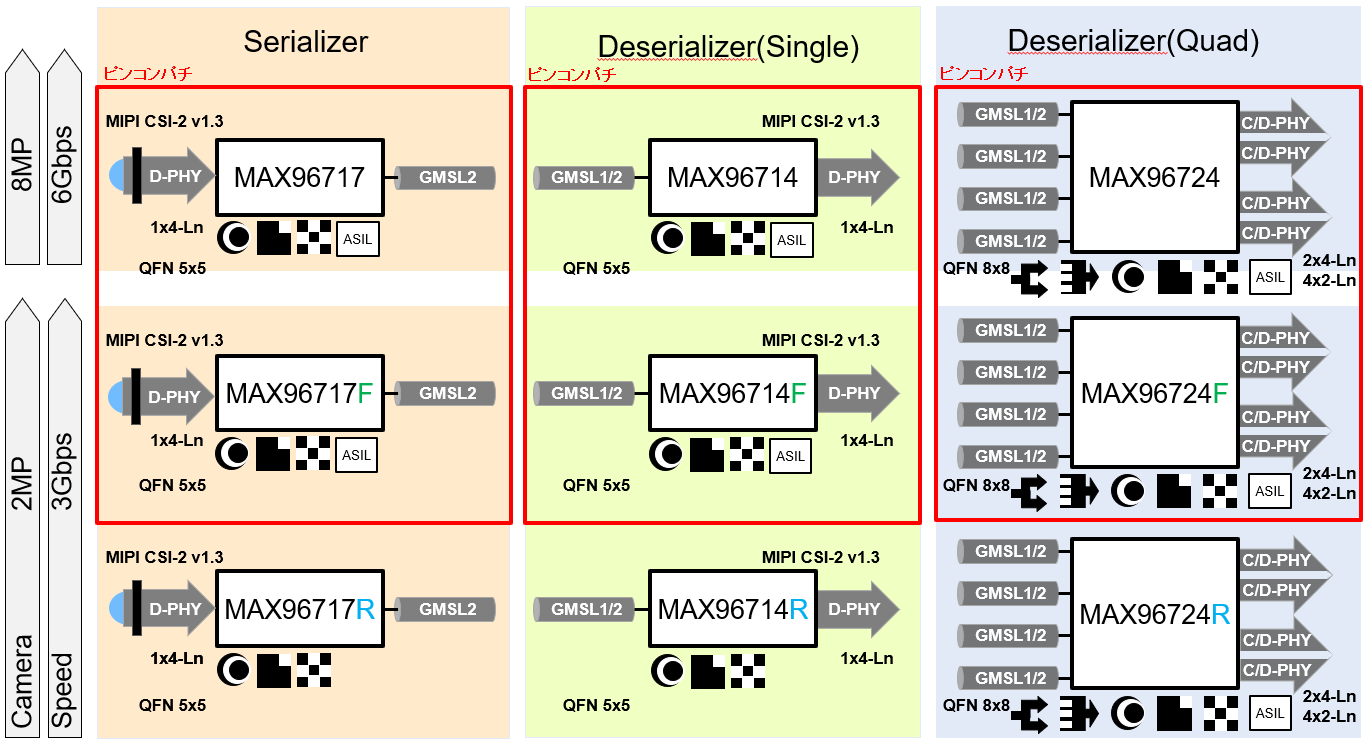
- Analog Devices, Inc.
- NEXT Mobility
- ICT and Industrial
1. Trends in Automotive Cameras
While automotive cameras traditionally had resolutions around 1 to 2 megapixels, recent rapid advancements in ADAS (Advanced Driver Assistance Systems) have created a demand for higher pixel counts in sensing cameras. Figure 1
GMSL from ADI (formerly MAXIM) is already widely used for high-speed video data transmission in vehicles.
While GMSL supported video up to 2 MP resolution, the newly released GMSL2 enables handling video data from higher-resolution cameras.
This page explains the features of ADI's (formerly MAXIM) next-generation GMSL, GMSL2.
- Hereinafter, we will refer the current generation of GMSL as GMSL1, and the next generation as GMSL2.

Figure 1 Trends in Automotive Camera Resolutions
2. Comparison of GMSL1 and GMSL2 technologies
GMSL1’s maximum forward channel transmission rate is 3 Gbps, supporting camera resolutions up to 2 MP/30 FPS.
In contrast, GMSL2's transmission rate has doubled to 6Gbps, now supporting camera resolutions up to 8 megapixels at 36 frames per second.
GMSL1 uses PCLK as the reference clock, with transmission rates varying based on PCLK, whereas GMSL2 utilizes an external reference clock (25 MHz), enabling fixed transmission rates (3 Gbps or 6 Gbps).
GMSL2 also complies with safety level ASIL-B and includes additional self-diagnosis and error detection features compared to GMSL1.

2. Comparison of GMSL1 and GMSL2
3. Backward Compatibility of GMSL2
Some GMSL2 products feature a backward compatibility mode that allows connection with GMSL1 devices.
Connection with the lower generation GMSL1 is possible by switching between GMSL1 mode and GMSL2 mode according to the generation of the connected SerDes device.
For example, using a GMSL2 product for the deserializer on the ECU side allows connection with either GMSL1 or GMSL2 serializers on the camera side.
This enables configurations such as standardizing the ECU and selecting cameras based on the model, allowing the reuse of previously designed GMSL1 cameras. (Figure 3, Figure 4)
Mixed GMSL1 and GMSL2 link configurations are also possible, providing flexible adaptation to specifications. (Figure 5)
-

Figure 3 Example configuration using only GMSL2
-

Figure 4 Example configuration using only GMSL1
(ECU can be shared with Figure 3) -

Figure 5 Example configuration mixing GMSL1 / 2
(ECU can be shared with Figure 3)
4. Lineup of GMSL2
The currently released lineup of GMSL2 for cameras consists of three families.

Figure 6 Example aggregating Video A through D and replicating the same data to Ports A and B.
5. MAX96724 Aggregation & Replication Function
The MAX96724 deserializer family features up to 4 GMSL inputs for processing multiple video streams.
After receiving Video A through D from each serializer, it is possible to aggregate the video data using the internal aggregator or replicate the video data to Port A and Port B via the internal CSI 2 controller for output.
The data path shown in Figure 6 is just one example. Using the Aggregation & Replication function allows support for configurations meeting various requirement specifications.
| Family | Serializer ⁄ Deserializer | Inputs | Outputs | ||
| Interface | Number of Channels | Interface | Number of Channels | ||
| MAX96717 | Serializer | CSI-2 | 1 Port | GMSL2 | 1ch |
| MAX96714 | Deserializer | GMSL1 ⁄ 2 | 1ch | CSI-2 | 1 Port |
| MAX96724 | Deserializer | GMSL1 ⁄ 2 | 4ch | CSI-2 | 2 Port |
Table 1: Comparison Table of GMSL2 Families.
Figure 7 shows a more detailed classification.
The top row of Figure 7 shows the base "no suffix" part numbers, followed by the "suffix F" and "suffix R" variants, which are cost-reduced versions with reduced functionality.
Suffix F part numbers have the transmission rate limited to 3Gbps, while "Suffix R" part numbers additionally have a QM safety level, representing the difference.
Additionally, the "no suffix" and "suffix F" parts are pin-compatible, enabling system optimization by swapping ICs on a shared PCB.

Figure GMSL2 Product Lineup
Evaluation Boards
Evaluation boards are available for all GMSL2 products introduced on this page. Please contact us for more information.
Evaluation Board Details
Related Info
Inquiry
Related Product Information

Low-Noise Switching Regulator Suitable for Power Supply in RF Products
Silent Switcher 3 is the latest switching regulator technology that achieves low low-frequency noise and fast load response.
- Analog Devices, Inc.
- ICT and Industrial

AI-Powered Smart Motor System for Motor Diagnostics
With the ADI OtoSense Smart Motor Sensor, let AI handle everything from threshold setting to analysis, diagnostics, and root cause identification—preventing downtime and avoiding losses.
- Analog Devices, Inc.
- NEXT Mobility
- ICT and Industrial
- Smart Factories and Robotics

New LTspice③ Parametric Analysis and Tolerance Analysis
LTspice is a free SPICE simulator provided by Analog Devices. This article introduces methods for parametric and tolerance analysis, as well as how to use dot commands.
- Analog Devices, Inc.
- NEXT Mobility

New LTspice②: How to Use SPICE Models
LTspice is a free SPICE simulator provided by Analog Devices. This article introduces how to obtain demo circuits and various models.
- Analog Devices, Inc.
- NEXT Mobility

New LTspice Complete Guide ①
LTspice is a free SPICE simulator provided by Analog Devices. This article explains the updates and performance improvements in the latest version, LTspice24.
- Analog Devices, Inc.
- NEXT Mobility

Introduction to Wireless Gesture Sensors (Use Cases for Analog Devices Products)
The wireless gesture sensor developed by NEXTY Electronics enables remote control of home appliances and display devices at low cost.
- Analog Devices, Inc.
- NEXT Mobility
- ICT and Industrial
- Smart Factories and Robotics

